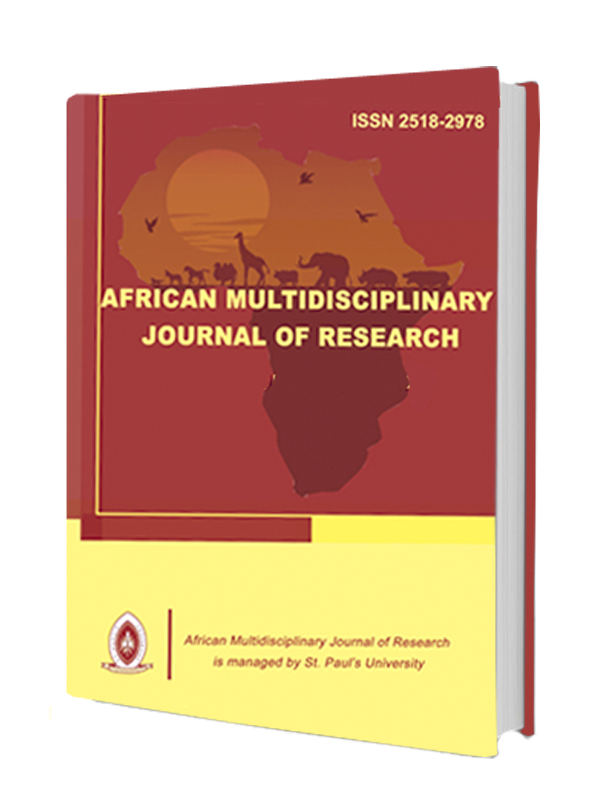DOES UNIVERSITY EDUCATION PRODUCE “HALF-BAKED” GRADUATES? PERSPECTIVES FROM GRADUATES OF A KENYAN UNIVERSITY
##plugins.themes.academic_pro.article.main##
Abstract
University education in Kenya has had an exponential growth in terms of the number of chartered universities and that of students’ enrolment over the past decade. This phenomenal growth has been occasioned by the need to increase access to higher education in line with the Kenya Vision 2030. However, concerns have been raised among educational stakeholders as to whether this exponential growth in quantity matches with the production of quality graduates to meet current and future industrial needs of the country. This study, therefore, aimed at investigating the aforementioned through a graduate tracer survey (GTS) in one of the Kenyan universities with the view of investigating in retrospect, the perceptions of graduates regarding the status of university education in terms of study conditions, provisions, experiences, teaching and learning conditions; investigating graduates’ experiences as they transited to the labour market; and finally, assessing the relevance of the skills offered at university to the requirements of the labour market. The study was anchored on the Context, Input, Process and Product (CIPP) model of curriculum evaluation. By employing the expost facto research design and cross- sectional survey method, data was collected for three months (April-July, 2016) from a target population of 360 graduates of Laikipia University (LU). The target cohort was that of 2013 graduates both from the Bachelor of Education (B.Ed.-Arts) and Bachelor of Commerce (B.Com) programmes. An online questionnaire was administered, via the SoSci Platform in collecting data from which, the data was transferred to the SPSS programme for analysis. The findings, among others, revealed that more than half (53%) of the graduates did not have access to ICT facilities at the university while only 27 per cent of those who had access to ICT had some knowledge in accessing learning resources. Library facilities were rated below average with availability of e-resources and adequacy of library space being rated as very bad especially from the satellite campus graduates. The study also established that less than one third of the participants rated their experiences in research as either good or very good. It was also revealed that a graduate from the university took an average of about 10 months to get a job both due to limited jobs in area of specialization and corruption issues. In addition, majority (86 per cent) of the B.Com graduates took additional training in order to improve their employment chances. It was further revealed that even though most skills acquired at the university were relevant and highly utilized in the work place, university contribution particularly towards the attainment of ICT skills was low in spite of the skill being in high demand. This study therefore recommends among others that the university institutes measures towards integrating ICT in teaching and learning for quality curriculum delivery. Further, the university needs to expand library space and stock relevant resources for library users especially in the satellite campuses. Additionally, the B.Com curricular should be reviewed to incorporate relevant content as per the current needs of the industry.
Keywords: Graduates, labour market, quality, relevance, skills, study conditions.
##plugins.themes.academic_pro.article.details##
References
- Cheboi, B. (2006). Funding patterns and their effects on quality of higher education in Kenya. Presented at Kenyatta University. Kenyatta University Conference. Nairobi: Kenyatta University.
- Commision for University Education. (2013). Draft guidelines for university courses. Nairobi: Commision for University Education.
- Eshiwani, G. (2009). University expansion in Eastern Africa: Challenges and options in higher education. Inter- University Council for East Africa (IUCEA) Newsletter, 39, 17-22.
- Gudo, C. O., & Olel, M. A. (2011). Students’ admission policies for quality assurance: Towards quality education in Kenyan universities. International Journal of Business and Social Science, 2 (8) 177-183.
- Gudo, C., Olel, M., & Oanda (2011). University education in Kenya and issues of quality education: Challenges and prospects. International Journal of Business and Social Sciences, 2(20) 203-214.
- Manyasi, B. (2010). OL and DE as a means of increasing access to higher learning in Kenya. A Journal of the KIM School of Management, 1, 123-130.
- Ndethiu, S. N. (2007). Role of Kenyatta University in promoting good reading habits among the undergraduate students. Unpublished PhD Thesis, Kenyatta University, Kenya.
- Okwakol, M. J. N. (2008). Challenges and prospects for quality assurance in science and technology education in African Countries. The Uganda Higher Education Review. Journal of the National Council for Higher Education, 5, 17-26.
- Republic of Kenya. (2006). Transformation of higher education and training in Kenya to secure Kenya’s development in knowledge economy: Report of The Universities Inspection Board (Kinyanjui Report). Nairobi: Government Printer.
- Republic of Kenya. (2007). Kenya Vision 2030. Nairobi: Government Printer.
- Riechi, A. O. (2008). Demand for academic programmes offered in Kenya’s public universities and their relevance to the labour market. Retrieved November 11, 2013, from www.csae.ox.ac.uk/.../265-riechi.pdf
- Stufflebeam, D. L. (1971). The use of experimental design in educational evaluation. Journal of Educational Measurement, 8(4), 267-274.
- World Bank. (2000). Higher education in developing countries: Peril and promise. Washington D.C.: World Bank.

